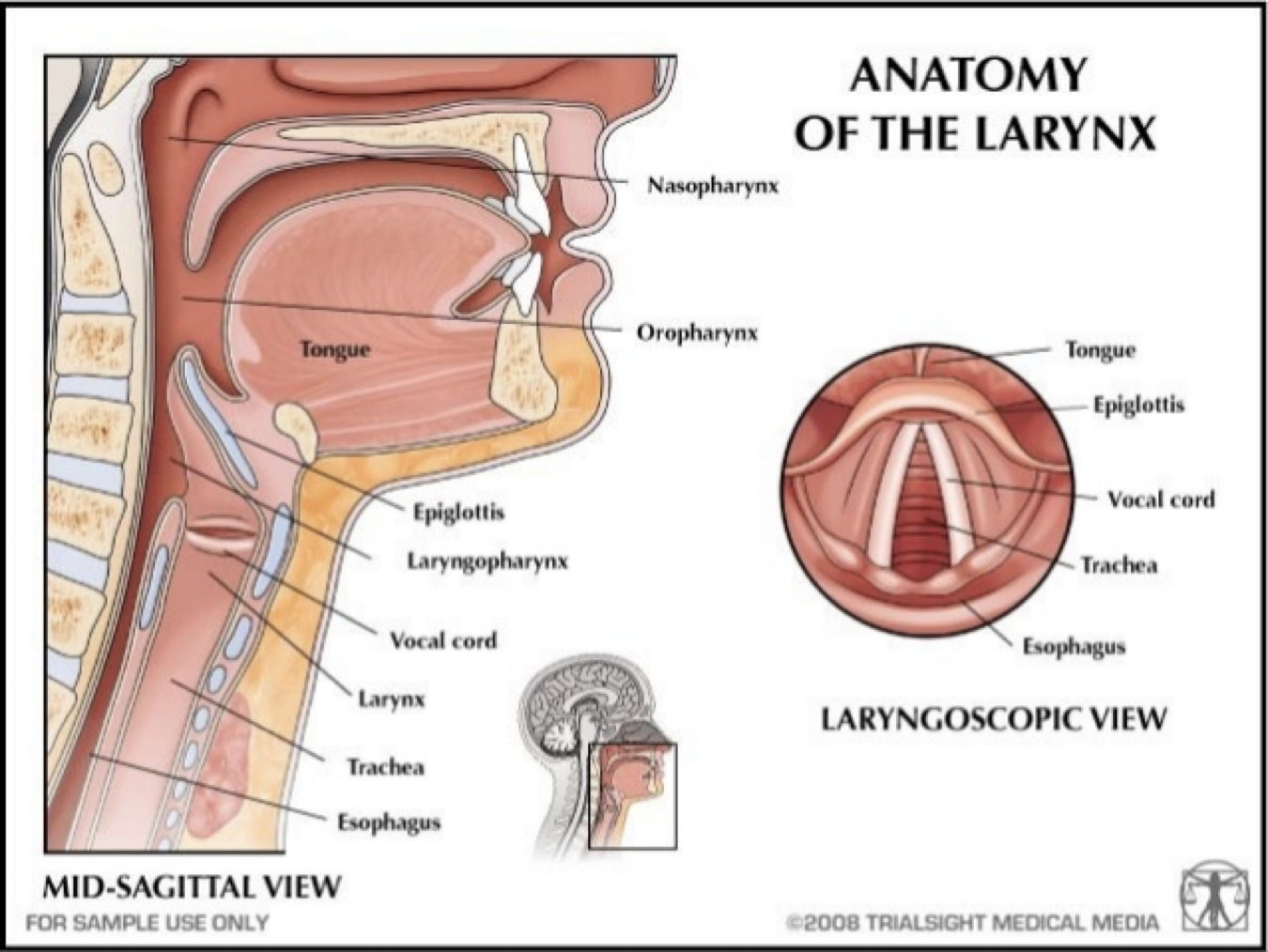
Chapter 6: Voice Disorders
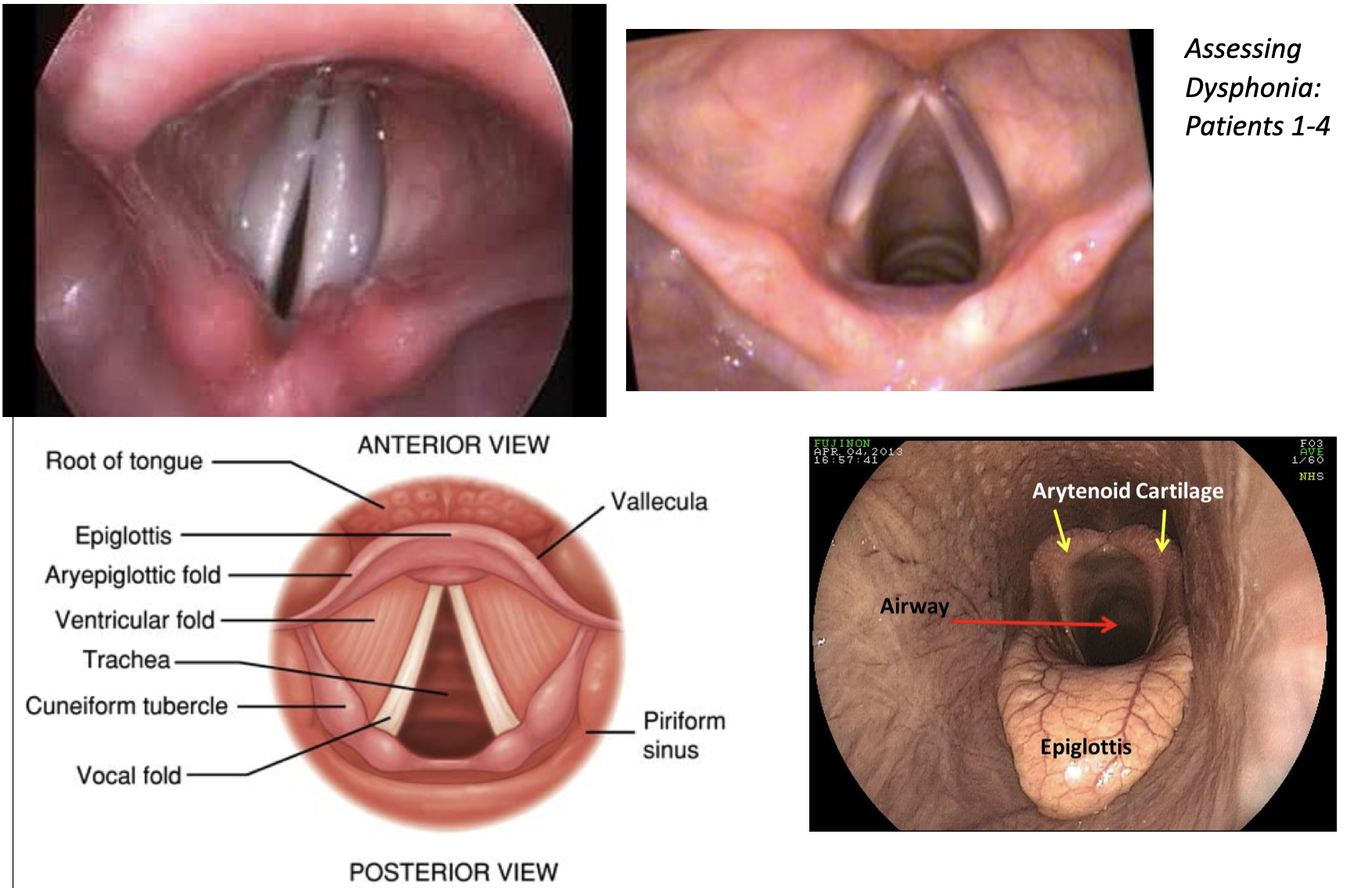
Basic Vocabulary
Words
Edema - Swelling
Velum - Soft Pallet
Aphonia - Loss of Voice
Atrophy - Reduction in Tissue
Hyperfunction - Increased Muscle Activity
Hypofunction - Reduced Muscle Activity
Prefixes
A - total loss
Dys - abnormal
Hyper - over/excessive
Hypo - under/inadequate
Ad - to/toward
Ab - away from
Voice quality can be described:
Harsh - excessive muscle tension
Breathy - partial whisper
Hoarse - voice that is both harsh and breathy, irregular vocal fold vibrations
Speech Language Pathology - vocal folds in action
Vocal Fold Abnormalities that Affect Voice
a variety of structural changes in the vocal folds can affect the voice
Nodules - calluses that develop on the vocal folds
Most common form of vocal fold abnormality
Male children 5-10 years old and adult females
Extroverted, “talkers”
Hoarse voice quality
Nodules form in pairs at the point of maximum contact along the length of the vocal fold where the amplitude of vibration is greatest
Patient alters phonatory behavior to eliminate vocal abuse, the nodules will almost always be eliminated
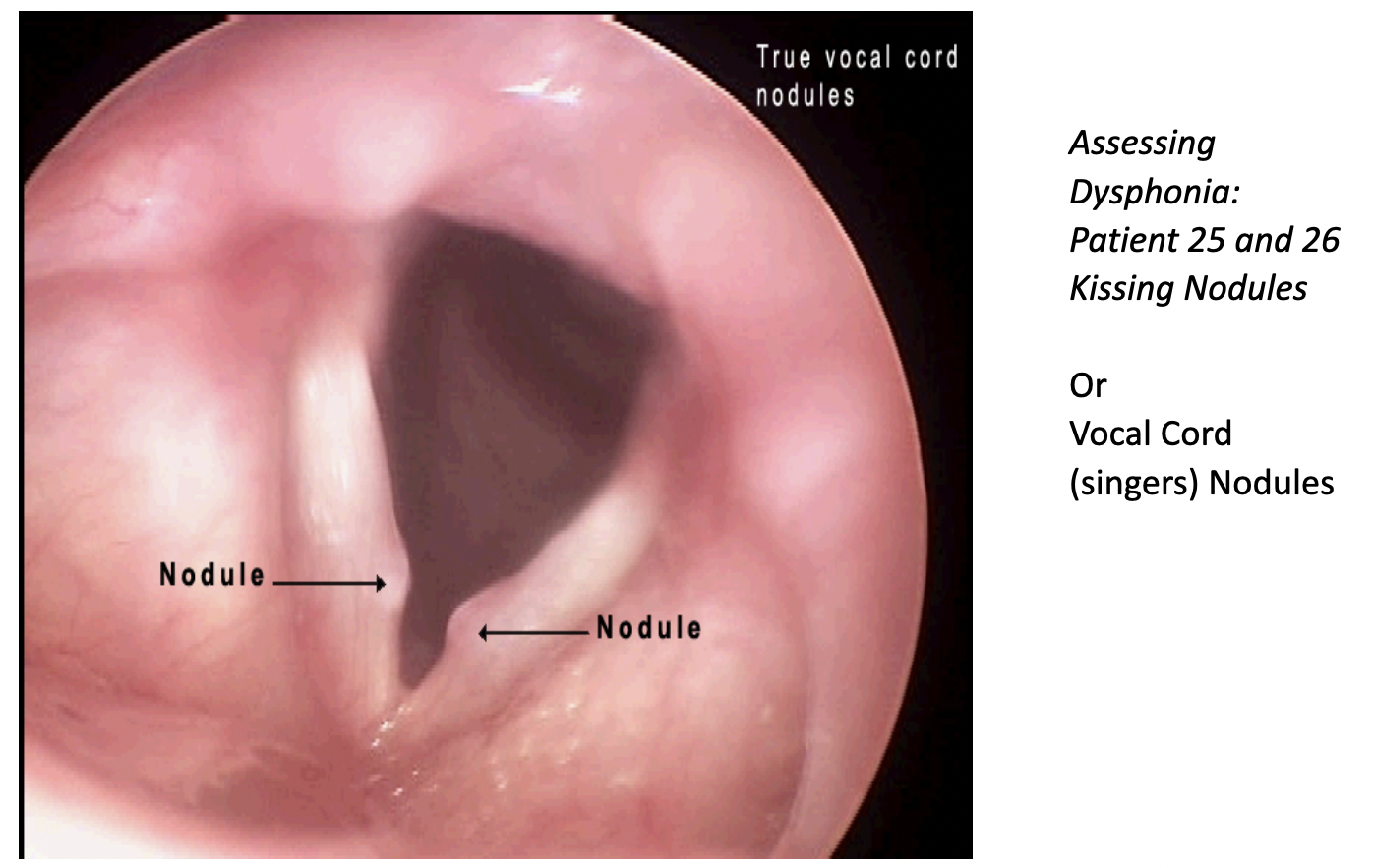
Vocal Misuses and Abuses of the Larynx
Talking in a noisy environment
Yelling, screaming, or cheering
Frequent coughing or clearing of the throat
Giving speeches or lectures
Using caffeine products
Spending time in smoky environments
Treatment Techniques
Yawn-Sigh
Vocal folds are abducted during a yawn and they are not fully adducted during a sigh
Helps patient feel/hear/produce a less tense sounds
Extend breathy phonation into vowels, open syllables, words, phrases, and sentences
Polyps
Polyps - Blisters
Polyps are relatively common
Shapes:
Pedunculated - small balloons connected to the vocal fold by a narrow foot
Sessile [ˈseˌsīl] - spread over a relatively large area of the vocal fold
Abuse (one time), unilateral, breathy/hoarse
Voice therapy to reduce vocal misuse/abuse, surgery
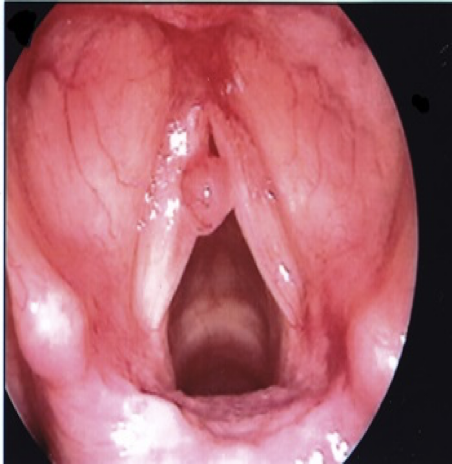
Contact Ulcers
Contact ulcers and the granulomas that develop at sites of ulceration arise at the vocal processes (on the vocal folds between the arytenoids cartilages)
Site is further back than the midpoint where nodules and polyps typically form
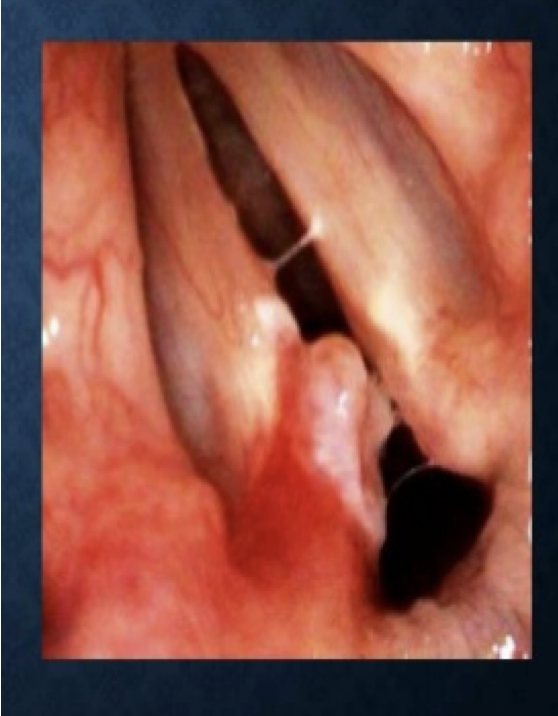
Causes:
Excessive slamming together of the arytenoid cartilages during the production of low pitches
Frequent nonproductive coughing and throat clearing
Gastric reflux
Intubation trauma
Papilloma
The human papillomavirus can cause warts on the vocal folds
Grow large
Not common
Hoarse voice quality
Surgery, developing good vocal hygiene
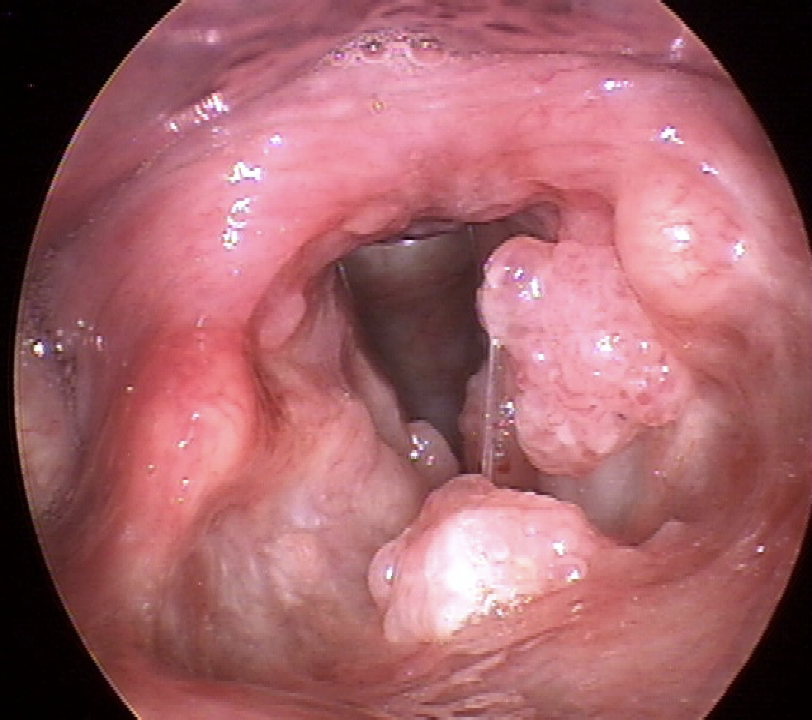
Carcinoma
Carcinoma - Cancer of the larynx
Frequently arises from exposure to inhaled smoke
Preoperative and postoperative care is laryngectomy is needed
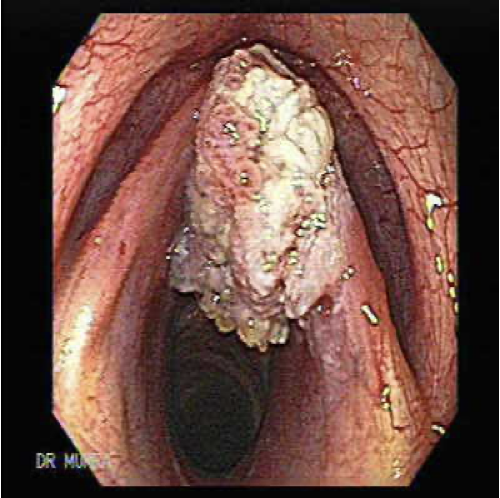
Voice Disorders Resulting from Neurological Impairment
Paresis - partial loss of the capacity to carry out a voluntary movement
Paralysis - total loss of the capacity to carry out a voluntary movement
Paralysis
Paralysis Causes - Cranial nerve cut in surgery (usually vegas), Stroke
Treatment for Unilateral Vocal Fold Paralysis
Unaffected side “overadducts” to approximate the paralyzed fold
Surgery involves physically moving the affected vocal fold closer to midline so that the unaffected fold can contact it during phonation
Bilateral Paralysis
Bilateral paralysis is less frequent
Results from CNS damage
If neural input to both recurrent laryngeal nerves is eliminated both fold assume a static position, glottis is compromised resulting in difficulty breathing (dyspnea)
Surgery
Voice typically remains functional
Spasmodic Dysphonia
Rare disorder
Accepted as a neurological problem involving a disturbance in the basal ganglia that causes disordered muscle tonicity
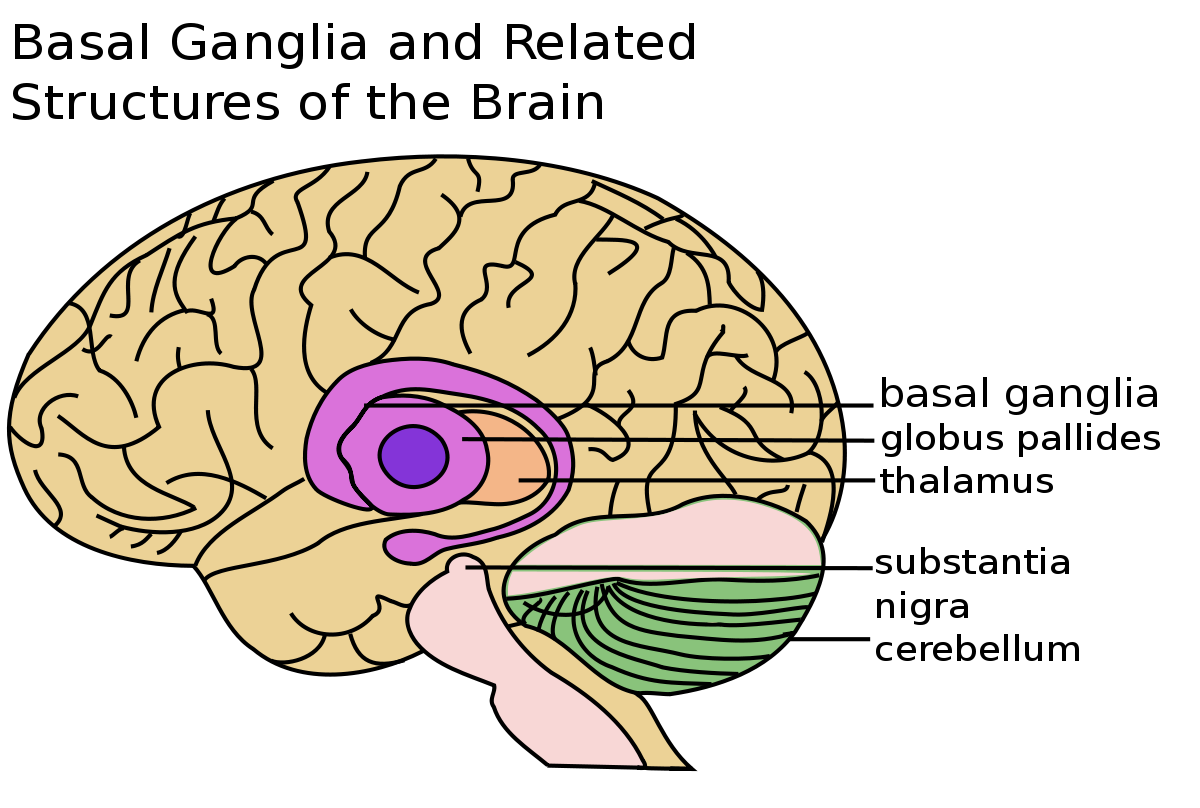
Types:
Adductor spasmodic dysphonia - strain-strangled voice quality, uncontrolled contractions of the adductor muscles
Abductor spasmodic dysphonia - causes inappropriate contraction of the laryngeal abduction muscles, periods of aphonia
Mixed spasmodic dysphonia - sudden abductions as well as sudden adductions
Dysphonia Treatment - Botox into the vocal folds
Vocal Abnormalities Unrelated to Structural Change
Conversion Aphonia/Dysphonia - patient reports change/loss of voice but medical examination fails to uncover an organic cause for the problem
Psychogenic cause of the voice disorder may be suspected
Sudden onset
Careful interview
Restored within an hour
Referral to a mental clinician
Voice Disorders
Puberphonia - mutational falsetto involves the continued use of a high-pitched voice by a post pubertal male
Functional disorder
Easy correction
Muscle Tension Dysphonia - caused by inordinate tension in the laryngeal muscles
Result from the simultaneous contraction of the muscles that close and open the vocal folds
Hypertensive, “knots”
Benefits from laryngeal massage
Hoarse
Report fatigue and laryngeal discomfort
Hard driven, upwardly mobile, Type A personalities
Voice Evaluation
Voice Evaluation Team - otolaryngologist, speech therapist
Voice Evaluation Interview - History (how voice disorder started, etc.)
Perceptual Assessment - clinician makes judgements regarding the pitch, volume, and quality of voice during a variety of tasks (sometimes recorded)
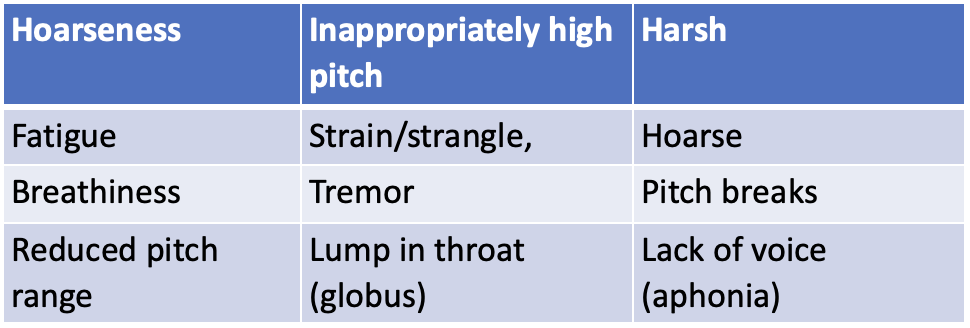
Clinicians use scales for grading vocal parameters
Assessments
The Consensus Auditory Evaluation of Voice (CAPE-V)
The Voice Handicap Index (VHI)
Instrumental Evaluation
Flexible videoendoscopy
Stroboscopy - slow motion technique that allows the clinician to examine closely the movement characteristics of the vocal folds
Visi-Pitch - provides objective data on a number of acoustic parameters
Laryngectomy
Laryngectomy - removal of the larynx (cancer)
Surgical removal of the larynx requires that the trachea be redirected to an opening on the front of the neck known as the tracheal stoma
Artificial larynx
Electrolarynx
Esophageal Speech
Esophageal Speech - air is actively injected down the esophagus past an area known as the pharyngeal-esophageal (PE) segment
Air is released and passes by the PE segment and draws the walls of the esophagus into vibration, much like air passing through the true vocal cords
Esophageal walls are much larger in mass - esophageal speech is much lower in pitch
Tracheoesophageal Speech
Tracheoesophageal Speech - air is routed from the lungs into the esophagus via a tracheoesophageal speech prosthesis
Additional surgery to create a small opening between the trachea and esophagus in which the prosthesis is inserted
Cover the stoma or be fitted with a valve
Most natural speech with the least therapy
Prevention of Voice Disorders
Vocal Hygiene is daily regimen of good habits to maintain the health of your vocal folds
These include eliminating inappropriate vocal habits and situations that place unnecessary wear and tear on the voice and common-sense behaviors which contribute to efficient voice production and overall voice health
The following is a list of some tips for keeping your voice healthy:
Avoid irritants:
cigarettes and secondhand smoke
manage reflux with over the counter (OTC) medication/see an ENT who specializes in voice disorders for prescription medications which may be less drying
Take care of your body:
Maintain good hydration: Drink 6-8 ounce glasses of water/day
Rest
Exercise
Good Nutrition
Maintain good vocal habits:
Avoid throat clearing and coughing
Avoid whispering
Warm up your voice before making big demands on it
Avoid repeated stress on the voice
Use good posture
Control environmental factors that may negatively impact your voice
Chapter 6: Voice Disorders

Basic Vocabulary
Words
Edema - Swelling
Velum - Soft Pallet
Aphonia - Loss of Voice
Atrophy - Reduction in Tissue
Hyperfunction - Increased Muscle Activity
Hypofunction - Reduced Muscle Activity
Prefixes
A - total loss
Dys - abnormal
Hyper - over/excessive
Hypo - under/inadequate
Ad - to/toward
Ab - away from
Voice quality can be described:
Harsh - excessive muscle tension
Breathy - partial whisper
Hoarse - voice that is both harsh and breathy, irregular vocal fold vibrations
Speech Language Pathology - vocal folds in action
Vocal Fold Abnormalities that Affect Voice
a variety of structural changes in the vocal folds can affect the voice
Nodules - calluses that develop on the vocal folds
Most common form of vocal fold abnormality
Male children 5-10 years old and adult females
Extroverted, “talkers”
Hoarse voice quality
Nodules form in pairs at the point of maximum contact along the length of the vocal fold where the amplitude of vibration is greatest
Patient alters phonatory behavior to eliminate vocal abuse, the nodules will almost always be eliminated

Vocal Misuses and Abuses of the Larynx
Talking in a noisy environment
Yelling, screaming, or cheering
Frequent coughing or clearing of the throat
Giving speeches or lectures
Using caffeine products
Spending time in smoky environments
Treatment Techniques
Yawn-Sigh
Vocal folds are abducted during a yawn and they are not fully adducted during a sigh
Helps patient feel/hear/produce a less tense sounds
Extend breathy phonation into vowels, open syllables, words, phrases, and sentences
Polyps
Polyps - Blisters
Polyps are relatively common
Shapes:
Pedunculated - small balloons connected to the vocal fold by a narrow foot
Sessile [ˈseˌsīl] - spread over a relatively large area of the vocal fold
Abuse (one time), unilateral, breathy/hoarse
Voice therapy to reduce vocal misuse/abuse, surgery

Contact Ulcers
Contact ulcers and the granulomas that develop at sites of ulceration arise at the vocal processes (on the vocal folds between the arytenoids cartilages)
Site is further back than the midpoint where nodules and polyps typically form

Causes:
Excessive slamming together of the arytenoid cartilages during the production of low pitches
Frequent nonproductive coughing and throat clearing
Gastric reflux
Intubation trauma
Papilloma
The human papillomavirus can cause warts on the vocal folds
Grow large
Not common
Hoarse voice quality
Surgery, developing good vocal hygiene

Carcinoma
Carcinoma - Cancer of the larynx
Frequently arises from exposure to inhaled smoke
Preoperative and postoperative care is laryngectomy is needed

Voice Disorders Resulting from Neurological Impairment
Paresis - partial loss of the capacity to carry out a voluntary movement
Paralysis - total loss of the capacity to carry out a voluntary movement
Paralysis
Paralysis Causes - Cranial nerve cut in surgery (usually vegas), Stroke
Treatment for Unilateral Vocal Fold Paralysis
Unaffected side “overadducts” to approximate the paralyzed fold
Surgery involves physically moving the affected vocal fold closer to midline so that the unaffected fold can contact it during phonation
Bilateral Paralysis
Bilateral paralysis is less frequent
Results from CNS damage
If neural input to both recurrent laryngeal nerves is eliminated both fold assume a static position, glottis is compromised resulting in difficulty breathing (dyspnea)
Surgery
Voice typically remains functional
Spasmodic Dysphonia
Rare disorder
Accepted as a neurological problem involving a disturbance in the basal ganglia that causes disordered muscle tonicity

Types:
Adductor spasmodic dysphonia - strain-strangled voice quality, uncontrolled contractions of the adductor muscles
Abductor spasmodic dysphonia - causes inappropriate contraction of the laryngeal abduction muscles, periods of aphonia
Mixed spasmodic dysphonia - sudden abductions as well as sudden adductions
Dysphonia Treatment - Botox into the vocal folds
Vocal Abnormalities Unrelated to Structural Change
Conversion Aphonia/Dysphonia - patient reports change/loss of voice but medical examination fails to uncover an organic cause for the problem
Psychogenic cause of the voice disorder may be suspected
Sudden onset
Careful interview
Restored within an hour
Referral to a mental clinician
Voice Disorders
Puberphonia - mutational falsetto involves the continued use of a high-pitched voice by a post pubertal male
Functional disorder
Easy correction
Muscle Tension Dysphonia - caused by inordinate tension in the laryngeal muscles
Result from the simultaneous contraction of the muscles that close and open the vocal folds
Hypertensive, “knots”
Benefits from laryngeal massage
Hoarse
Report fatigue and laryngeal discomfort
Hard driven, upwardly mobile, Type A personalities
Voice Evaluation
Voice Evaluation Team - otolaryngologist, speech therapist
Voice Evaluation Interview - History (how voice disorder started, etc.)
Perceptual Assessment - clinician makes judgements regarding the pitch, volume, and quality of voice during a variety of tasks (sometimes recorded)

Clinicians use scales for grading vocal parameters
Assessments
The Consensus Auditory Evaluation of Voice (CAPE-V)
The Voice Handicap Index (VHI)
Instrumental Evaluation
Flexible videoendoscopy
Stroboscopy - slow motion technique that allows the clinician to examine closely the movement characteristics of the vocal folds
Visi-Pitch - provides objective data on a number of acoustic parameters
Laryngectomy
Laryngectomy - removal of the larynx (cancer)
Surgical removal of the larynx requires that the trachea be redirected to an opening on the front of the neck known as the tracheal stoma
Artificial larynx
Electrolarynx
Esophageal Speech
Esophageal Speech - air is actively injected down the esophagus past an area known as the pharyngeal-esophageal (PE) segment
Air is released and passes by the PE segment and draws the walls of the esophagus into vibration, much like air passing through the true vocal cords
Esophageal walls are much larger in mass - esophageal speech is much lower in pitch
Tracheoesophageal Speech
Tracheoesophageal Speech - air is routed from the lungs into the esophagus via a tracheoesophageal speech prosthesis
Additional surgery to create a small opening between the trachea and esophagus in which the prosthesis is inserted
Cover the stoma or be fitted with a valve
Most natural speech with the least therapy
Prevention of Voice Disorders
Vocal Hygiene is daily regimen of good habits to maintain the health of your vocal folds
These include eliminating inappropriate vocal habits and situations that place unnecessary wear and tear on the voice and common-sense behaviors which contribute to efficient voice production and overall voice health
The following is a list of some tips for keeping your voice healthy:
Avoid irritants:
cigarettes and secondhand smoke
manage reflux with over the counter (OTC) medication/see an ENT who specializes in voice disorders for prescription medications which may be less drying
Take care of your body:
Maintain good hydration: Drink 6-8 ounce glasses of water/day
Rest
Exercise
Good Nutrition
Maintain good vocal habits:
Avoid throat clearing and coughing
Avoid whispering
Warm up your voice before making big demands on it
Avoid repeated stress on the voice
Use good posture
Control environmental factors that may negatively impact your voice
 Knowt
Knowt